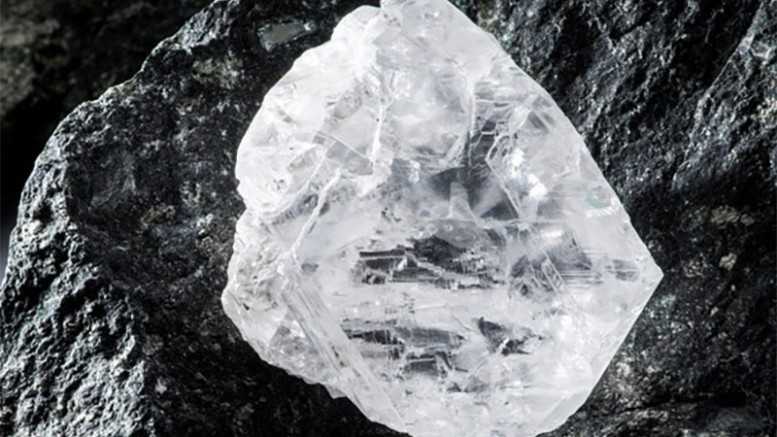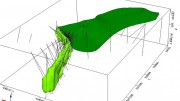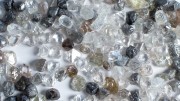After a 12-15% decline in rough diamond prices last year, 2016 has seen a stronger start to the year. Even so, Edward Sterck, Director of Equity Research, Metals and Mining at BMO Capital Markets, is forecasting a flat year for diamond prices in 2016.
The London, U.K.-based mining analyst spoke with Diamonds in Canada in April about what that means for diamond equities and why he’s optimistic about the diamond market beyond 2016.
Diamonds in Canada: What can we expect in terms of diamond prices this year after a substantial decline last year and a relatively flat 2014?
Edward Sterck: I think if we get rough prices remaining roughly flat then it will have been a good year. We’ve had a reasonably strong start to the year so far — better than the market had been anticipating. Just in terms of demand, if you look at the De Beers and Alrosa sights as proxies for the market as a whole, prices have lifted a bit, but I think the likelihood is we’ll probably see a little bit of softening in terms of the pace of demand. Prices will probably end up back where we started 2015 — that’s exactly where I think I think we’ll finish 2016.
DiC: Despite your outlook for flat prices this year, you have an outperform rating on most of the diamond companies that we’ll be talking about today: Dominion Diamond (TSX: DDC; NYSE: DDC) Stornoway Diamond (TSX: SWY) and Mountain Province Diamond (TSX: MPV; NASDAQ: MDM). So why are diamond equities a good place to invest right now?
ES: I’ve got a forecast of flat prices for this year, but if one looks at next year and beyond that, I’m expecting prices to increase 5-7% per annum. Now for the purpose of my modelling, I flatten prices after a couple of years, but 5-7% is in line with the historical rate of diamond price appreciation. So there’s nothing particularly startling in that.
That, I think is a pretty attractive element for investors and if one compares the diamond stocks as a subsector to the whole of the mining sector, the valuation multiples are very attractive.
Furthermore, the balance sheets are generally stronger than the other mining subsectors and if you look at the cash generation going forward, the dividends they’ve started paying, they just stack up really well compared to most of the rest of the mining sector.
To put that into perspective, roughly speaking on 2017 EV/EBITDA multiples, the diamond stocks are trading at less than 3 times, which looks very good compared to, for example, the golds stocks which are trading at an average of around 9 times.
DiC: There was a bit of a liquidity crisis for diamond cutters and polishers in late 2014 and into 2015 that hurt diamond prices. Has that liquidity issue been resolved?
ES: I think it has, yes. The industry’s in a better position at the moment and people are generally feeling just a little bit more comfortable with everything with the diamantaires exhibiting higher cash flows, lower debt and so on. However, there is always the possibility that the lenders within the industry may in the future continue to downscale their exposure.
DiC: You noted in a report about a year ago that diamond producers are pretty strong and resistant to a substantial decline in rough prices because of their strong operating margins and strong balance sheets. So how have they fared with the 12-15% drop in diamond prices last year?
ES: I think they’ve weathered the storm pretty well. They still have strong balance sheets — the exception would be Petra Diamonds (LSE: PDL) which is still going through a period of significant capital investment. So last year was a little bit tough for them. For the rest of the space, particularly the Canadian diamond stocks, balance sheets remain strong and in strong financial position. Cash generation last year did take a hit with the decline in diamond prices, but still remained good when compared to the producers of other commodities.
DiC: The bigger diamond producers last year reacted to the drop in rough prices by holding back some inventory from the market and letting sightholders defer purchases. Are the big producers still holding substantial inventories?
ES: De Beers and Alrosa (MICEX: ALRS) allowed significant customer purchase deferrals and ended the year with something like $1.5 billion worth of inventory above normal levels of working inventory. At the same time, De Beers actually curtailed production in response to market conditions, so production guidance for this year is pretty much flat on last year, which was itself lower than in 2014. The lower production from De Beers means that with normalized demand for diamonds, that inventory should be consumed relatively quickly. For Alrosa, it may take a little bit longer if they have the production levels of last year which were fairly strong.
I think one of the key factors that resulted in the price decline last year was the absence of big Chinese jewelers from the market. If one looks at Chow Tai Fook and Luk Fook and some of the mainland jewellers, they were operating inventory levels based upon an expectation that Chinese demand would continue growing in the high 20% range. But nothing lasts forever, and demand dropped to the low teens because of the economic slowdown in China and the clamp down on “gift giving.” As a consequence, the Chinese retailers were running down those excess inventories themselves last year and they were more or less completely absent from the diamond market.
And that really resulted in the price pullback as the non-Chinese diamantaires also became skittish — if you’ve got 12-15% of the market absent, it has an effect. That’s the other thing about that excess inventory, is if or when we see the Chinese jewellers come back to the market then the restocking could consume the inventories carried over from last year relatively quickly. There are some indications that the mainland Chinese jewellers have begun restocking, but the big Hong Kong and Macau jewellers still appear to be absent.
DiC: We’ve got two diamond mines in Canada that are going to be starting production this year — Gahcho Kué (owned by De Beers and Mountain Province Diamonds) and Renard (owned by Stornoway Diamond). Are they going to be selling their production into a healthy market?
ES: We’re looking at next year in terms of a first material diamond sale so my expectations are that we’ll see normalization of market conditions by then — the situation should be improved from where we are today. And that’s really good news for those guys.
DiC: Is production from those two mines enough to affect diamond prices at all?
ES: Not really. In my view these are high-quality operations but the production volumes are not that material from a global perspective.
DiC: Your top diamond pick is Dominion Diamond — you have a $22 target on the stock, which is trading around $15.50 at presstime. Why the gap between your valuation and the trading price?
ES: The disconnect reflects in part the softening of diamond prices seen last year, which impacts the producers more that the development companies. There have also been some board changes at Dominion due to investor pressure, and the communication from the company has not necessarily been totally clear in terms of its mine plans, so investors have struggled to understand the corporate strategy. The attractive aspect of Dominion is that the company is expected to generate really serious cash flow once it starts getting into mining the Misery Main pipe, which is within the existing mine plan. But with sales from the Misery pipe not expected until the second half of this year, I think investors have just taken the view of why buy it now when you can buy it in 6 months and jump on the bandwagon then?
That’s one factor and the other is they have plans to develop the Jay pipe. In their figures, that’s funded internally and on my forecasts Dominion should still have significant levels of excess cash beyond that to return to investors. But I think there’s an erroneous view in the market that Jay may consume the cash generated from Misery so therefore, we wouldn’t really get a massive benefit from Misery.
DiC: You mentioned communication — what is it that shareholders want to hear from Dominion?
ES: I think just a well-articulated mine plan that remains consistently in place for a period of time. They took over the Ekati mine from BHP Billiton (NYSE: BHP; LSE: BLT) a few years ago in a situation which made it quite hard for them to report their mine plan given that not all of the ore being mined had been defined to National Instrument 43-101 standards as BHP didn’t need to worry about that.
The mine plan that’s been communicated to the market as time has gone on has changed on a fairly frequent basis. As a consequence I think that’s created a little bit of uncertainty in investors’ minds.
DiC: Lucara Diamond (TSX: LUC) completed a $55-million plant upgrade last spring at Karowe and they subsequently recovered some pretty impressive diamonds — one of them was over 1,100 carats and now they’re putting in a mega-diamond recovery circuit to recover diamonds over 1,000 carats. How likely are they to find more gem-quality diamonds of that size there?
ES: I think that’s a question that can’t be answered, I’m afraid. We just don’t know.
However, one assumes that the company has enough confidence in the size frequency distribution to justify the investment.
DiC: The cost of the recovery circuit is only US$15-18 million, so that’s not a huge spend for them.
ES: No, and I would imagine that they wouldn’t make the investment unless they were confident that it would pay for itself. To put that into perspective, we don’t know the value of the 1,111-carat diamond, but if you look at some of the numbers that are being put around in the press and on the street, just one of those diamonds will pay for the mega-diamond recovery circuit quite easily.
DiC: Stornoway’s stock price has been taking off as they get closer to production later this year. They just released a new mine plan — what were your impressions of the plan?
ES: It was a little bit less than my previous estimates, so costs were a bit higher and diamond prices were lower. They take a very conservative view with their diamond price assumptions. So it was a bit of a negative on the numbers, but not enough to change my Outperform recommendation.




Be the first to comment on "Q&A: Why diamond stocks haven’t lost their shine"